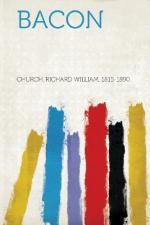And this was not all. The death of Essex was a shock to the popularity of Elizabeth greater than anything that had happened in her long reign. Bacon’s name also had come into men’s mouths as that of a time-server who played fast and loose with Essex and his enemies, and who, when he had got what he could from Essex, turned to see what he could get from those who put him to death. A justification of the whole affair was felt to be necessary; and Bacon was fixed upon for the distinction and the dishonour of doing it. No one could tell the story so well, and it was felt that he would not shrink from it. Nor did he. In cold blood he sat down to blacken Essex, using his intimate personal knowledge of the past to strengthen his statements against a friend who was in his grave, and for whom none could answer but Bacon himself. It is a well-compacted and forcible account of Essex’s misdoings, on which of course the colour of deliberate and dangerous treason was placed. Much of it, no doubt, was true; but even of the facts, and much more of the colour, there was no check to be had, and it is certain that it was an object to the Government to make out the worst. It is characteristic that Bacon records that he did not lose sight of the claims of courtesy, and studiously spoke of “my Lord of Essex” in the draft submitted for correction to the Queen; but she was more unceremonious, and insisted that the “rebel” should be spoken of simply as “Essex.”
After a business of this kind, fines and forfeitures flowed in abundantly, and were “usually bestowed on deserving servants or favoured suitors by way of reward;” and Bacon came in for his share. Out of one of the fines he received L1200. “The Queen hath done something for me,” he writes to a friendly creditor, “though not in the proportion I had hoped,” and he afterwards asked for something more. It was rather under the value of Essex’s gift to him in 1594. But she still refused him all promotion. He was without an official place in the Queen’s service, and he never was allowed to have it. It is clear that the “Declaration of the Treason of the Earl of Essex,” if it justified the Government, did not remove the odium which had fallen on Bacon. Mr. Spedding says that he can find no signs of it. The proof of it is found in the “Apology” which Bacon found it expedient to write after Elizabeth’s death and early in James’s reign. He found that the recollection of the way in which he had dealt with his friend hung heavy upon him; men hesitated to trust him in spite of his now recognised ability. Accordingly, he drew up an apology, which he addressed to Lord Mountjoy, the friend, in reality half the accomplice, of Essex, in his wild, ill-defined plan for putting pressure on Elizabeth. It is a clear, able, of course ex parte statement of the doings of the three chief actors, two of whom could no longer answer for themselves, or correct and contradict the third. It represents the Queen as implacable




